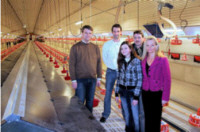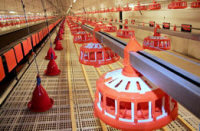



The benefits of modern broiler housing
This article, written by Big Dutchman, reviews the benefits of two newly constructed broiler parent houses in Neulehe, Germany, which were opened earlier this year.For many years now, Big Dutchman housing equipment has stood for sophisticated technology and proven quality. This also convinced the Ruberg family from Neulehe, Germany, who contracted the worldwide market leader to equip two broiler-parents houses for the production of hatching eggs. The results were recently inspected by approximately 300 invited guests on the occasion of an open day. The open day was housed by the Ruberg family and the companies who participated in the construction of the buildings.
 |
| left to right: Hermann-Gerd Roter and Werner Meckelnborg (company Big Dutchman) with the Ruberg family |
Several factors influence the performance of breeders: amongst others this includes, of course, animal health and house hygiene, as well as feed and water supply, house climate and management, as well as the right nest design. The requirements made on modern and efficient broiler breeder management are correspondingly high. Thanks to Big Dutchman's many years of experience and competence, high requirements are no problem at all: the housing equipment manufacturer once again succeeded in providing optimum conditions for the birds who are moved into the 105x14 m houses in week 16 and week 18, respectively.
Core part of the system is the one-tier group laying nest MB. Thanks to the reliable expel system, the birds are not able to sleep or brood in the nest, that means the nest stays clean. The nest entrance is equipped with a foot rail made of open profile sheet. That means there are no hidden corners thus providing ideal conditions for easy mite abatement - which is an important advantages in regard to nest hygiene. Short rolling distances ensure good egg quality and a low share of cracked and hair-cracked eggs.
 |
| Single-tier group laying nest MB (house 1) |
The three meter wide, continuous manure pit is covered with Integra plastic slats. Thanks to their design, the slats feature a good manure penetration ensuring optimum hygiene and cleaning conditions. At the same time, Integra slats are easy-to-walk on for the birds and foot-friendly.
Feeding is carried out separated by sex. For the hens, feed is supplied by means of the REPROMATIC feeding system, a combination of chain and pan feeding, developed by Big Dutchman, which combines the advantages of both systems. Both houses of the Ruberg-family were equipped with four Repromatic loops each. The main goal during the production phase is to steer the hens in their development so that all hens of the flock ideally start their egg laying activities at the same time. However, to accomplish this, the following conditions have to be fulfilled: sufficient feeding space and a uniform filling of the pans. In this context, the Big Dutchman FluxxBreeder feed pan is an ideal solution: with 16 feeding spaces it provides a comparatively high stocking density, also it is variable in feeding space width and height, provides a good feed distribution and it furthermore very user-friendly. Additional advantage: during the feeding time, the birds can move back and forth between the feed pans without disturbing each other eating.
 |
| : two of the four REPROMATIC-loops with FluxxBreeder.Between feed line and nest: round drinker Jumbo. |
To ensure a high fertilisation rate, adequate feeding of the males has to be ensured as well. With the separate male feeding system MALE PAN of which two lines per house are installed, Big Dutchman provides the optimum solution. The birds receive a defined amount of feed and it is of course also possible to use a different recipe than that of the hen feed. At the same time it is possible to pull the feed lines up so that the hens are no longer able to reach the pans. At Big Dutchman, hygiene is a big issue. The design of both pan types allows for easy and thorough cleaning. Water is supplied to the birds by two lines of the proven JUMBO round drinkers.
The optimum house climate is controlled by Big Dutchman's successful climate and production computer Viper. The computer can be used for all established types of ventilation, including side, cross, tunnel or combi-tunnel ventilation. It controls fresh and exhaust air based on the temperatures inside and outside the house and on the age of the birds. At the same time, Viper registers important data regarding production, growth, feed and water consumption thus covering all important production functions. That means the Rubergs are in a position to quickly react to changing conditions and immediately take the required measures. Result: better bird performance and increased economic efficiency. And the last point is of course as important in regard to labour requirements for the Ruberg family, since Viper and MC95 control feeding and ventilation automatically and will thus help to save time!
 |
| Jet master |
Corresponding fresh air supply and exhaust air removal units as well as heating devices from Big Dutchman make for draft-free fresh air supply, uniform temperatures and overall good air quality in the bird area. The supply of fresh air is controlled by means of flange inlets which are installed in sandwich panels thus providing for stable negative pressure ventilation. On very warm days, so-called shutters make for fast air movement (windchill-effect). The exhaust air is removed from the house at the gable side over the tower and a water bath.
Ideal temperatures in the house which are also important for health and performance of the birds are ensured by the JET MASTER heater. The device can be operated with natural gas or propane and ensures an excellent distribution of warm air inside the building.
Furthermore, the Ruberg family decided on the following additional proven "accessories" from the Big Dutchman product range: two storage silos and two day silos, a feed scale, a bird scale and an egg cross conveyor 350 with farm packer unit help to increase the production yield.












